#blue and white faience
Explore tagged Tumblr posts
Text
i was doing some spring cleaning (lie)(i watched the bear S2E4 - got sad - went on denmark’s insta - got emotional - opened pinterest for fic research - got teary again - checked under the sink for pads bc surely it’s coming - rummaged af - found it??) and remembered i was given this by a Chinese exchange student who lived in the same student building as me, after i’d help her out with a lost necklace.
it just occurred to me that i could google translate with a photo, so i could read what the writing was on the box, but i’m not very trustful of the accuracy and the literal translation rather than a native one. even with the google translation, i am not sure what it is meant to mean, if the specific design on the porcelain keychain has a specific meaning, etc.
any help and reblogs would be deeply appreciated!
and to you, friend, i don’t know where you are in the world right now, but know that everytime i pick up your gift (bc silly me keeps changing its place) i think of you very, very fondly, and even many times you randomly pop into my mind and it makes me feel a little better 💙 thank you for your gift, and for the thought, and for the reminder. i hope everything is going, and always will be well 💙
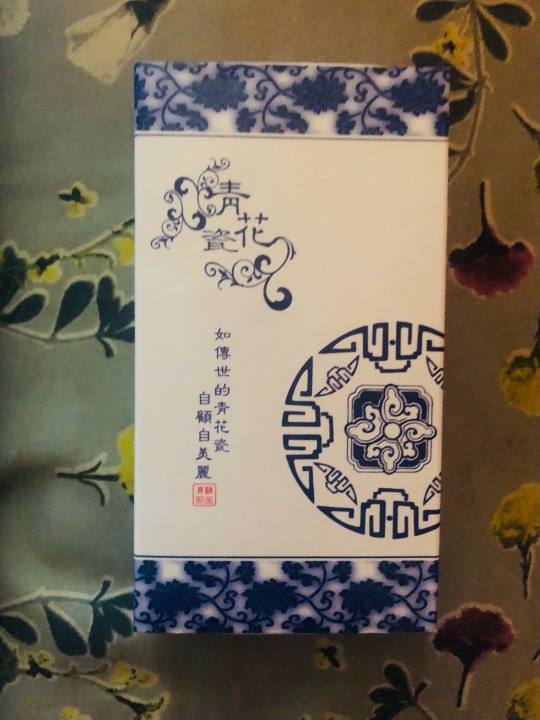
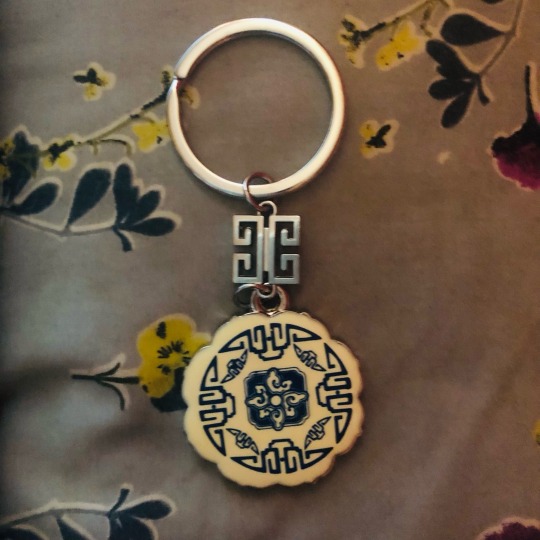

(yes, i am now crying over this porcelain piece of art and this friendly & sweet stranger)
#now how does adler tag this#lemme know if there are other tags i can add to help the search#chinese translation#mandarin translation#blue and white china#porcelain#chinese porcelain#blue and white porcelain#blanc de chine#chinese ceramics#chinese language#blue and white#blue-and-white#blue flowers#blue and white pottery#blue and white ceramics#ceramics#pottery#faience#blue and white faience#learning chinese#learning mandarin#adler.priv
8 notes
·
View notes
Text
Word List: Fashion History
to try to include in your poem/story (pt. 2/3)
Exomis - a short, asymmetrical wrap garment pinned at the left shoulder, worn by men in Ancient Greece
Eye of Horus - or Wedjat eye, is an ancient Egyptian symbol that represents the eye of the falcon-headed god Horus and symbolizes healing and regeneration and was often worn for protection
Faience - a man-made ceramic material that was often used in ancient Egypt to make jewelry and devotional objects; it is usually a blue color
Falling Band - a flat and broad white collar often with lace on the edges, worn by men and women in the 17th century
Fibula - served as a pin to both hold garments together and to show status of those with prestige or power within society; was popular in Greek culture
Fichu - a triangular shawl, usually worn by women, draped over the shoulders and crossed or fastened in the front
Fontange - a linen cap with layers of lace and ribbon, worn flat and pinned to the back of the head
French Hood - a rounded headdress for women that was popular in the 16th century (from 1540)
Frock Coat - a collared man’s coat worn through the eighteenth to the twentieth century; rose to prominence mainly in the nineteenth century, especially Victorian England; characterized as a knee-length overcoat, buttoned down to the waist, that drapes over the lower half of the body like a skirt
Frogging - ornamental braid or cording that can function as a garment closure, or be solely decorative
Gabled Hood - a woman’s headdress that is wired to create a point at the top of the head and has fabric that drapes from the back of the head
Gigot Sleeve - a sleeve that was full at the shoulder and became tightly fitted to the wrist; also called leg-of-mutton sleeve
Guipure Lace - a type of continuous bobbin lace made without a mesh ground; its motifs are connected by bridges or plaits
Himation - a rectangular cloak wrapped around the body and thrown over the left shoulder worn by the ancient Greeks
Huipilli/Huipil - a woven rectangular shirt worn by women in Central America beginning in ancient times
Jerkin - a close-fitting men’s jacket, often worn for warmth, sometimes without sleeves; worn over a doublet in the 16th and 17th centuries
Justaucorps - a long-sleeved, knee-length coat worn by men after 1666 and throughout the 18th century
Kaftan - (also caftan) is an ancient garment, which originated in ancient Persia but then spread across Central and Western Asia; a kind of robe or tunic that was worn by both men and women
Katazome (stencil printing) - a traditional Japanese method for printing designs onto fabric using a stencil and paste-resist dyes
Kaunakes - one of the earliest forms of clothing; made from goat or sheep’s wool and meant to be worn around the waist like a skirt, it is recognizable by its fringe detailing
Kente - a Ghanaian strip woven textile that has striped patterns and bright colors with corresponding meanings
Knickerbockers - or “knickers” are full or baggy trousers gathered at the knee or just below and usually fastened with either a button or buckle; were initially worn by men in the late 19th century and gradually became part of women’s fashion; the garment was usually worn as sportswear and became especially popular among golfers and female cyclists, hence the term “pedal pushers”
Kohl - a black material made out of minerals such as galena and used for eyeliner and eye protection in ancient Egypt
Labret - a type of lip-piercing worn by various cultures to indicate wealth, prosperity and beauty
Love Lock - a lock of hair from the nape of the neck hanging over the chest to show romantic attachment; it was a popular hairstyle between 1590-1650
Lurex - a shiny synthetic fiber made of aluminum-coated plastic with a glittering metallic sheen
Mantua - a jacket-like bodice with pulled back overskirt that bustled in the back, often in elaborately patterned fabric, first worn in the 17th century
Medici Collar - a collar that stands upright on the back of the neck and opens in the front; this type of ruff was introduced to France by Marie de’ Medici in the 16th century, taking her name two centuries later
Moccasins - a type of soft animal skin shoe that were worn by Indians in North America
Muff - a tubular padded covering of fur or fabric, into which both hands are placed for warmth
Mule - a backless shoe
Muslin - a simple plain-weave textile made out of cotton and available in varying weights and finishes; historically, there were also varieties of muslin in silk and wool
Needle Lace -often known as “needlepoint lace”; is a term referring to the technique in which the lace is made of entirely needle work; it developed in the 15th century and then became very popular throughout the 16th century
Nemes Headdress - starched, striped linen headdress that draped on the shoulders and had a tail at center back worn only by royals in ancient Egypt
Panes/Paning - a method of decoration using long parallel strips of fabric arranged to reveal a contrasting fabric underneath that was fashionable from the 15th-17th centuries
Panniers - an under-structure used in eighteenth-century fashion that created a shape wide at the sides and flat at the front and back
Pantalettes - (also referred to as pantaloons) are loose, pants-like undergarments that covered women’s lower halves in the late 18th and early 19th century
Particolored - the combination of different colors within the same garment along the vertical axis
Passementerie - an additional accent or embellishment in silk or metallic threads, such as an embroidered braid, tassel or fringe
Pattens - wooden-soled platform over-shoes, which were commonly worn from the 14th century to the 18th century
If any of these words make their way into your next poem/story, please tag me, or leave a link in the replies. I would love to read them!
More: Fashion History ⚜ Word Lists
#word list#writeblr#spilled ink#dark academia#terminology#fashion history#history#words#studyblr#linguistics#writing prompt#fashion#writers on tumblr#poetry#literature#poets on tumblr#lit#culture#light academia#langblr#fiction#worldbuilding#creative writing#writing tips#writing advice#writing reference#writing resources
173 notes
·
View notes
Text

Faience jerboa with a white core and white and pale blue coating with brown detailing.
Middle Kingdom, 12th Dynasty, ca. 1976-1793 BC. From Heliopolis. Now in the Fitzwilliam Museum. E.279.1939
104 notes
·
View notes
Text

Ancient Egyptian hippo & hedgehog squad at the Brooklyn Museum!
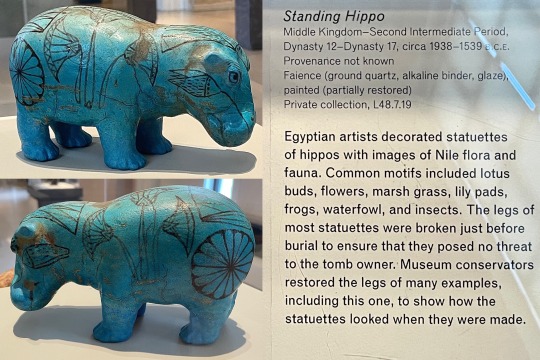
Standing Hippo
Middle Kingdom 2nd Int. Per. Dyn.12-17 c1938-1539BCE
Faience
��Egyptian artists decorated statuettes of hippos with images of Nile flora & fauna. Common motifs included lotus buds, flowers, marsh grass, lily pads, frogs, waterfowl, & insects. The legs of most statuettes were broken just before burial to ensure that they posed no threat to the tomb owner. Museum conservators restored the legs of many examples, including this one, to show how the statuettes looked when they were made.”
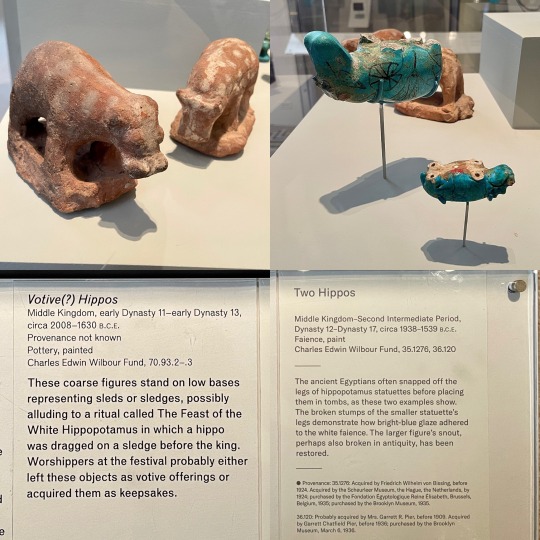
L: Votive(?) Hippos
Middle Kingdom Dyn.11-13 c2008-1630BCE
Painted pottery
“These coarse figures stand on low bases representing sleds or sledges, possibly alluding to a ritual called The Feast of the White Hippo in which a hippo was dragged on a sledge before the king. Worshippers at the festival probably either left these objects as votive offerings or acquired them as keepsakes.”
R: Two Hippos
Middle Kingdom Dyn.12-17 c1938-1539BCE
“The ancient Egyptians often snapped off the legs of hippopotamus statuettes before placing them in tombs, as these two examples show. The broken stumps of the smaller statuette's legs demonstrate how bright-blue glaze adhered to the white faience. The larger figure's snout, perhaps also broken in antiquity, has been restored.”
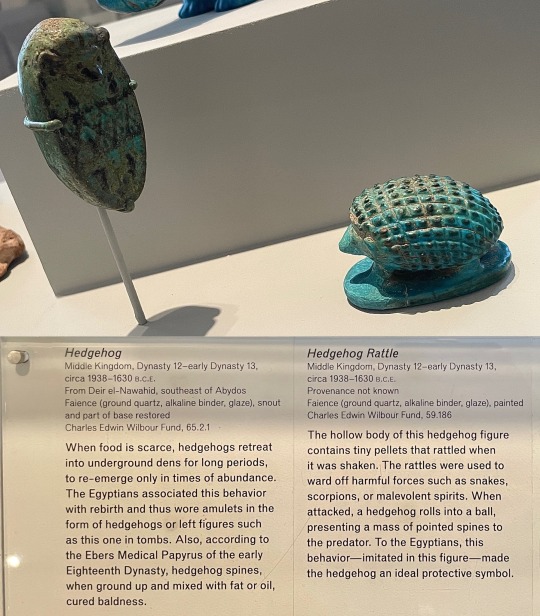
L. Hedgehog Rattle
Middle Kingdom Dyn. 12-13 c1938-1630BCE
Faience, 7.6 x 4.4 x 3.5 cm
“The hollow body of this hedgehog figure contains tiny pellets that rattled when it was shaken. The rattles were used to ward off harmful forces such as snakes, scorpions, or malevolent spirits. When attacked, a hedgehog rolls into a ball, presenting a mass of pointed spines to the predator. To the Egyptians, this behavior-_imitated in this figure-made the hedgehog an ideal protective symbol.”
R. Hedgehog Figurine
Middle Kingdom Dyn. 12-13 c1938-1630BCE
Faience, 4.2 x 4.1 x 7.1 cm
“When food is scarce, hedgehogs retreat into underground dens for long periods, to re-emerge only in times of abundance.
The Egyptians associated this behavior with rebirth and thus wore amulets in the form of hedgehogs or left figures such as this one in tombs. Also, according to the Ebers Medical Papyrus of the early Eighteenth Dynasty, hedgehog spines, when ground up and mixed with fat or oil, cured baldness.”
(note: labels are reversed - rattle is on L & figurine on R)
#animals in art#ancient art#Egyptian art#Ancient Egyptian art#Ancient Egypt#Brooklyn Museum#museum visit#hippo#hippos#hippopotamus#hippopotamuses#hedgehog#hedgehogs#pair#ceramics#pottery#faience#funerary art#votive#figurine#rattle
131 notes
·
View notes
Text
The thing about airlines that I think is neat is every once in a while you stumble on something a little...idiosyncratic, something unique to a carrier. Also, I go on about flag carriers and highlighting their nation's culture, so I feel like I would be remiss not to mention this.
There are a lot of different styles of faience (pottery utilizing white tin glaze) peculiar to very specific places, and one such style is Delftware, from the Dutch city of Delft. Although this term can technically refer to any pottery made in this style regardless of color, Delftware is traditionally known for being white and blue (a common motif in pottery in general, thanks to cobalt oxide being practically indestructible).
Blue and white! Just like KLM's livery! Yet another thing they could have capitalized on but didn't - there was even a Delftware-inspired design representing the Netherlands back when British Airways was doing their World Tails - but that's beside the point. Apparently if you fly Business Class on KLM (their highest class, they don't have First Class) to a whole other continent they'll give you one of these.

image: KLM
Their Delft Blue houses are little pottery sculptures of actual house façades in the Netherlands. That little nozzle sticking out where the chimney would be is actually the point of entry to some Dutch gin. People don't really care about the gin as much as they do about the houses, though. There's one design for every year KLM has existed, and they release a new one on their birthday (7 October). People collect these. Apparently there's an app.

They're really neat. As far as I can tell this is the only airline that gives their passengers earthenware as a bonus for upgrading their seats. You know, I've had a bit of a tense history with KLM recently, their livery got worse and their cabin crew uniforms aren't even really worth talking about, but they've won back some of my respect with these little things. I'm going to tentatively say...your move, every other carrier.
40 notes
·
View notes
Text
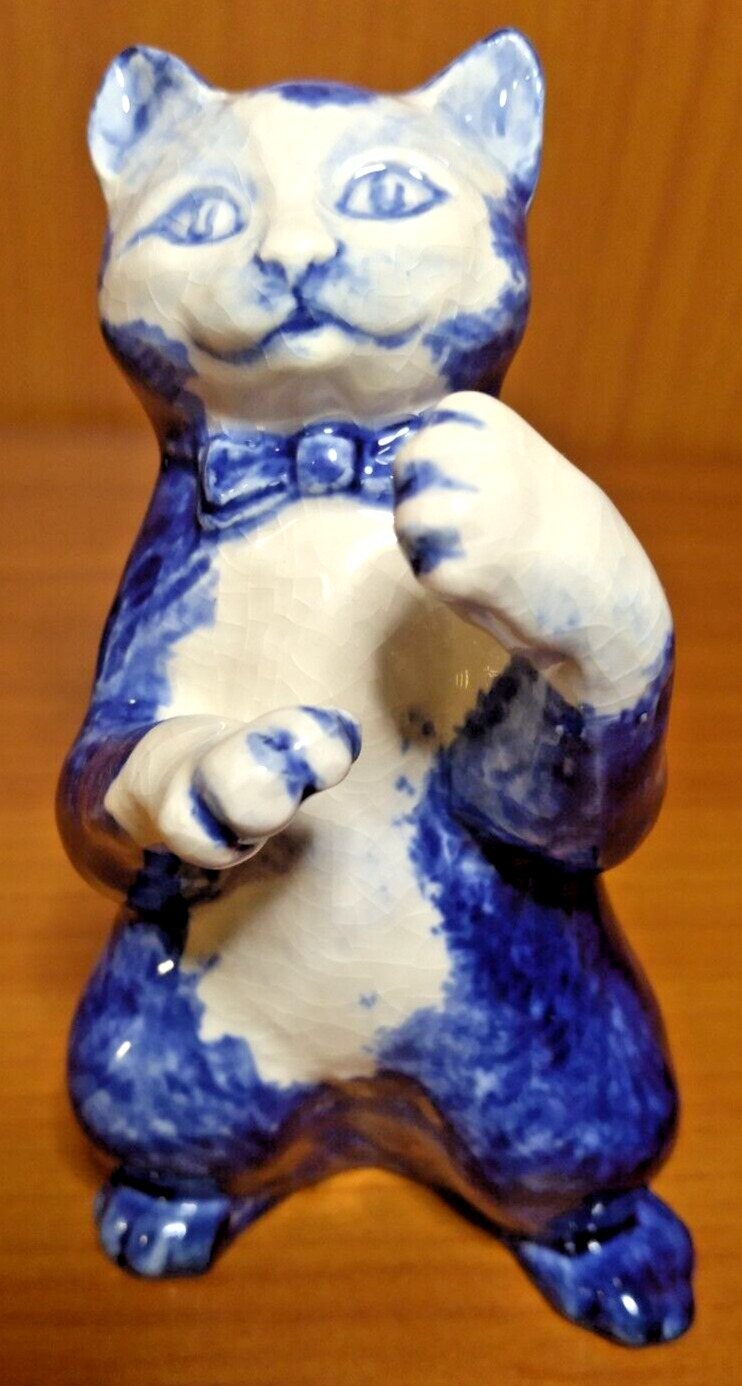

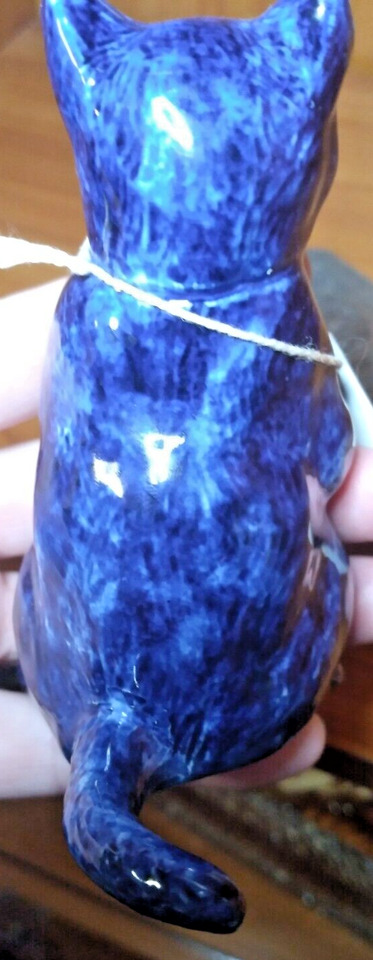
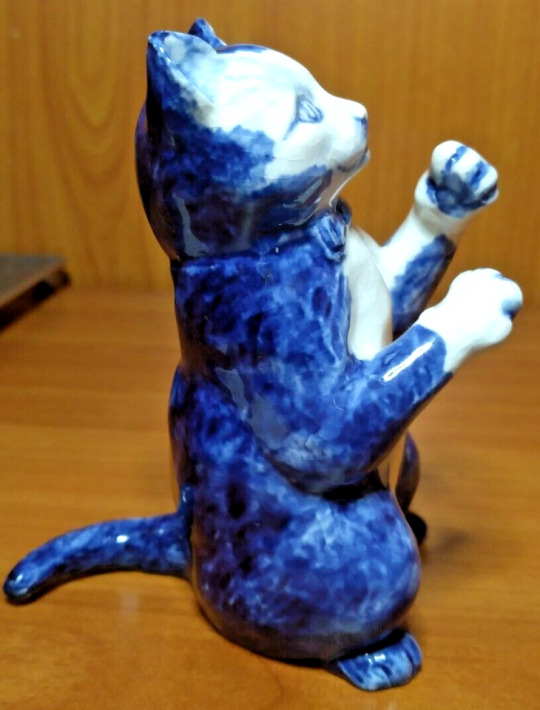
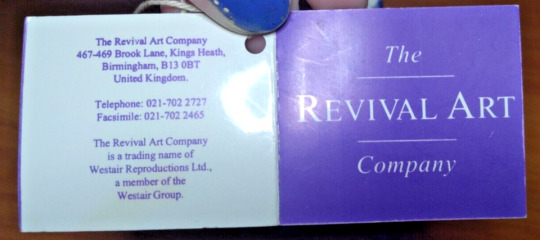
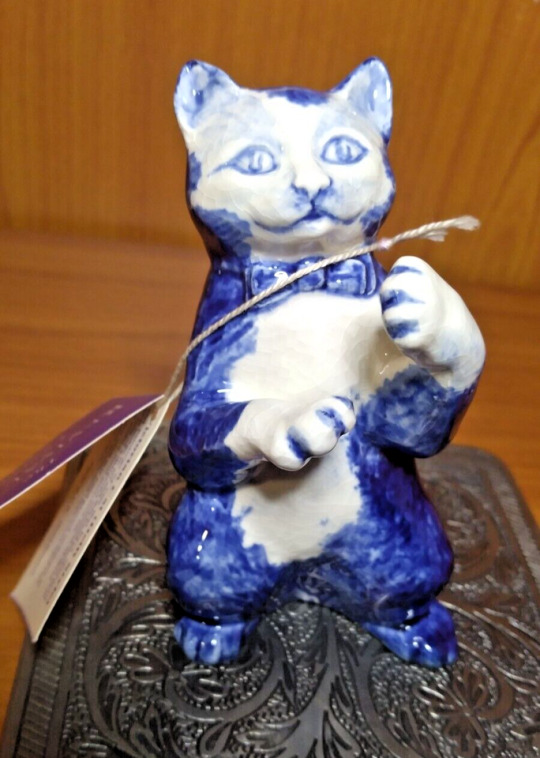

DELFT BLUE VICTORIAN CAT 'PLAYFUL' REVIVAL ART COMPANY ENGLAND 4" FAIENCE STYLE.FROM THE 1600'S TO THE PRESENT DAY CERAMIC ARTISTS HAVE USED THIS HAND PAINTED TECHNIQUE TO EMULATE THE FINE WHITE PORCELAINS OF CHINA AND JAPAN. EARLY BRITISH DELFT-TYPE WARES WERE VERY CLOSE IN STYLE TO THE CONTINENTAL MAJOLICA OR FAIENCE TYPE WARES.MADE IN U.K. HAND PAINTED. THE WHITE PAINT HAS NATURAL DESIGNED CRAZING AND THE BLUE IS SMOOTH.STOCK CODE: VPC/VSC/VCC.THE SCULPTURE COLLECTION. VICTORIAN CAT (DELFT STYLE). WEARING A CUTE BOW TIE.THIS CHARMING CAT IS INSPIRED FROM SCULPTURES AND PAINTINGS OF CATS THAT HAVE APPEARED THROUGHOUT HISTORY. THE CAT HAS ALWAYS BEEN A POPULAR IMAGE IN ART AND THIS HAND PAINTED BLUE AND WHITE CAT IS REMINISCENT OF THE VICTORIAN STYLE.+++ONE OF A DELIGHTFUL COLLECTION OF THREE--A SINGING CAT, A PLAYFUL CAT AND A CROUCHING CAT, THEY MAKE A MOST ATTRACTIVE SET.FREE SHIPPING. MEASUREMENTS IN DESCRIPTION. THANK YOU!#DAWNETTSEMPORIUM, #BEAUTIFULMERMAIDQUEEN, #SHAUNALYNNSFOOD.
7 notes
·
View notes
Text
What is Islamic Architecture?
Islamic Architecture is an architectural style that dominates Muslim-majority countries around the world such as Indonesia, Pakistan, Egypt, Saudi Arabia, Turkey and many more, but is not limited to these locations. Islamic architecture can be found across the globe - though the architecture in other locations may not hold all the main characteristics - there are definite elements that have been incorporated into the western, modern world, (The Spruce., 2022).
This architectural style is associated with the religion of Islam, and has evolved from various other architectural styles like that of Mesopotamian and Roman.
Islamic architecture has several characteristics that are recognisable to even the untrained eye; the use of colour, geometric shapes, symmetry, patterns and calligraphy define the architectural style (Invaluable., 2020). This style of architecture is typically associated with religious establishments in Islam such as the Mosque, but is not restricted to this, the style extends to palaces, tombs, forts and public buildings. One of the oldest elements to identifying Islamic architecture is the presence of Minarets and domes. Minarets are tower-like structures with small windows and enclosed spiral staircases made for muezzins (a man who calls Muslims to pray) to call to worshippers from a high point. The minarets often feature one or more balconies. The forms of the minarets commonly seen range from thick, squat, spiral ramps to soaring, delicate, pencil-thin spires, with the base usually being square in shape. The number of minarets located in a Mosque will vary from one to six and they stand as landmarks of Islam.
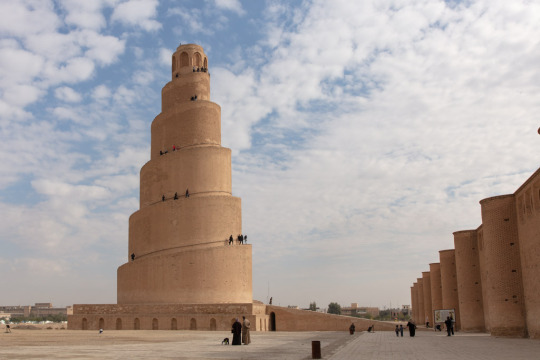
Grand Mosque of Samarra and the spiralling Malwiya Minaret (Adventures of Nicole., 2022).
Domes (like several other architectural movements such as Renaissance and Byzantine) are also a regular feature of islamic architecture.
The first Islamic design featuring a dome is a 7th century shrine in Jerusalem - Dome of the Rock, Arabic Qubbat al-Ṣakhrah. Dome of the Rock was built by Umayyad caliph (chief Muslim civil and religious ruler of the first Muslim dynasty) 'Abd al-Malik ibn Marwān. The structure is situated on a flat elevated plaza known to Muslims as 'The Noble Sanctuary' (al-Haram al-Sharīf), and the rock above which the dome is located is the spot the propet Muhammad was taken up into heaven for an encounter with God (Mi'rāj), (Britannica., 2014).
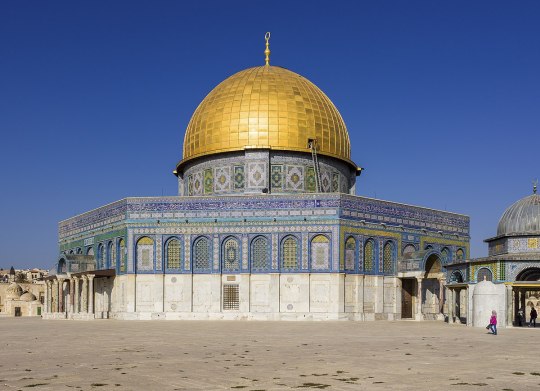
Dome of the Rock, Jerusalem, 691-692 CE.
Most domes rest on pendentives which are constructional devices used to place circular domes over square or rectangular shaped rooms. You can recognise pendentives as Islamic architecture by its decorative tiles or muqarnas - a form of ornamental vaulting, (IvyPanda.,2020).
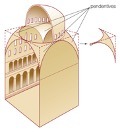
Diagram of pendentives.
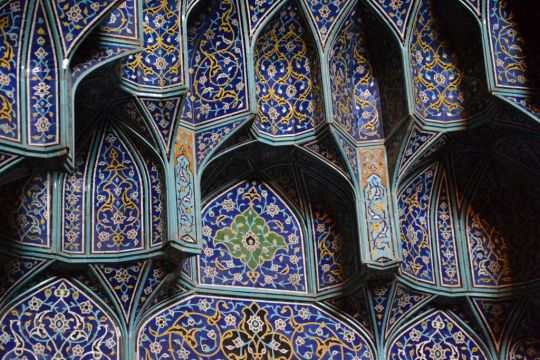
Muqarnas and decorative tiles example.
The most important piece of indo-Islamic architecture os the tomb of the Shah Rukn-i-Alam in Multan. This tomb was built between 1320 and 1324 CE by Giyath al-Din Tughluq in the pre-mughal, architectural style, Giyath was the governor of Diplapor (a city in the Okara District of the Punjab, Pakistan) and is thought to have been built to serve as a tomb for himself. However, it was presented to the family of the renowned Sufi saint Sheikh Rukn-ud-Din Abul Fateh (Sacred Sites., 2020). The tomb is an octagonal shape, 35m high and structured by red brick with a visible frame of beams and shisam wood, and further designed with the use of carved brick, wood blue and white faience mosaic tiles with raised relief patterns. The octagon is decorated with geometric, floral, and arabesque designs and calligraphic motifs. The interior was originally plastered but is now bare and the sarcophagus is surrounded by 72 of his descendants. The saint is still held in high esteem and the tomb is the focus of over 100,000 pilgrims from all over South Asia who visit in order to commemorate his memory, (Unesco., 2004).

Shah Rukn-i-Alam, Multan, Pakistan.
Arches are yet another prominent feature of identifying Islamic architecture, and their placements usually define the entrances to buildings and rooms. There are several types of arches including: Pointed Arches, Ogee Arches, Horseshoe Arches, and Multifoil Arches. The double arched system of the Mosque-Cathedral of Córdoba, the pointed arches of the Al-Aqsa masque provide excellent examples of how arches become indispensable features of Islamic architecture (Rethinking the Future., 2023).
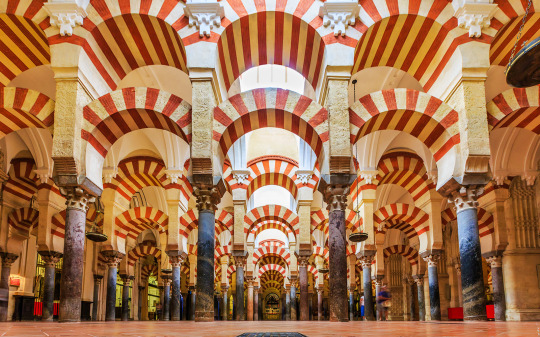
Double Arches of Mosque-Cathedral of Córdoba
The majority of mosques and palaces falling under the style of Islamic architecture feature courtyards and can house large gatherings of people during festive occasions and prayers. The courtyards will feature fountains for the people to perform ablution before prayers.
Now that there has been an introduction into what it takes to create for Islamic styled architecture, the rest of the blog is open to deeper dives of certain establishments, countries, and architects themselves,
Thank you for reading, I hope you enjoyed!
Summer Marshall-Miller
BIBLIOGRAPHY: Hohenadel, K. (2022) The Spruce. Available at: https://www.thespruce.com/what-is-islamic-architecture-5120474 (Accessed 20 January, 2023)
Britannica, The Editors of Encyclopaedia. (2014) Encyclopaedia Britannica. Available at: https://www.britannica.com/topic/mosque (Accessed: 20 January, 2023)
Unknown Author (2020) Invaluable. Available at: https://www.invaluable.com/blog/islamic-art-patterns/ (Accessed: 21 January, 2023)
IvyPanda (2020) 'Muqarnas in Islamic Architecture'. Available at: https://ivypanda.com/essays/muqarnas-in-islamic-architecture/ (Accessed: 24 January 2023)
UNESCO (2004) Tomb of Shah Rukn-e-Alam. Available at:https://whc.unesco.org/en/tentativelists/1884/#:~:text=The%20tomb%20of%20Shah%20Rukn,saint%20following%20the%20latter%27s%20death (Accessed 7th December 2022).
Unknown Author (2023) Rethinking the Future. Available at: https://www.re-thinkingthefuture.com/architectural-styles/a2589-10-distinctive-elements-of-islamic-architecture/ (Accessed: 23 January 2023).
Nicole Smoot (2022) The Adventures of Nicole. Available at: https://adventuresoflilnicki.com/samarra-iraq/ (Accessed: 23 January 2023).
#architecture#islamicarchitecture#art#history of art#islamic#mosque#history#my blogs#student#major project
33 notes
·
View notes
Photo

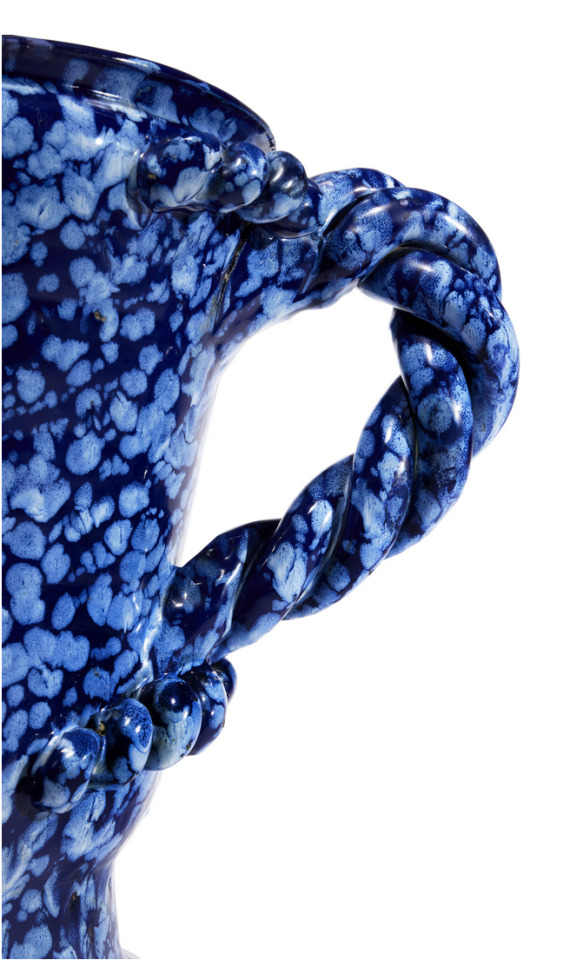

Jardinière - Nevers 'Bleu Persan' faience jardiniere, covered in a deep blue tin-glaze splashed overall in white, ca. 1690
Sotheby’s
13 notes
·
View notes
Text

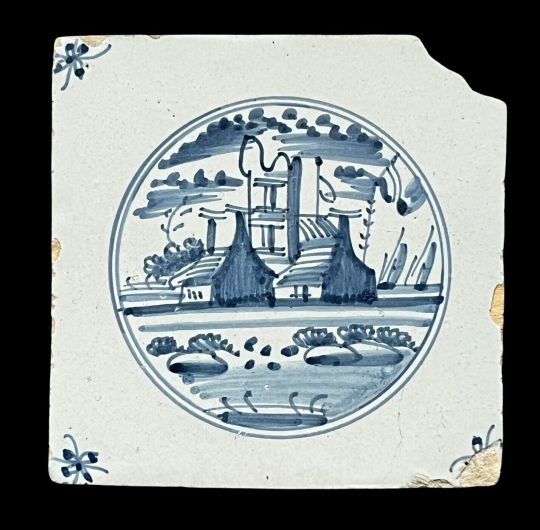
Antique Dutch Delft Faience Tile With House and Sailboat 18th Century Pine Frame ebay dave-h
Antique Dutch Delft Blue and White Tile with Houses and Boat 17th Century ebay easternredseas
2 notes
·
View notes
Text
White faience was not impossible to get, but it did take more effort than blue/green, since that was just "grind up the quartz into a powder, mash it together with water (which had natural salts in it), shape it, dry it, kiln it."
The colors of the "glaze" on faience depended on what was mixed into the quartz...and on whether or not it was dry or wet when kiln-fired.
That's the huge difference between Egyptian faience and ceramics made from clay. Clay has to be dry. It has to be bone dry before it can be fired, or microscopic water pockets will turn to steam and, trapped inside the smooth pressure of the clay, will explode, breaking the piece.
Faience is considerably more coarse. There's plenty of room for water to escape between the granules as it turns to steam. And when it does get to dry prior to being fired, there were often mineral salts in the mix that would self-glaze the piece, giving it color...but some would be different if you fired them while still wet, versus firing when dry.
I'm not completely sure how to get the white color shown above, but I do know it was considerably rarer. So that fish is a precious fish.
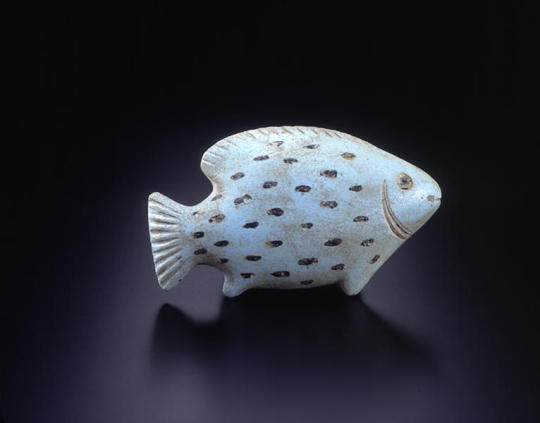
Your day would be better if you saw an Ancient Egyptian faience fish
8K notes
·
View notes
Link
Check out this listing I just added to my Poshmark closet: Majolica Italian CANTAGALLI Pottery Lamp Base Candle Stick Rooster Mark Antique.
0 notes
Photo

A sunny corner of the kitchen
Make a sun filled corner of the kitchen into a relaxing place to read and enjoy an afternoon cup of coffee or tea. I’ve just returned home from running my morning errands, thrown my jacket over the arm of my chair, and I’m looking forward to a refreshing cup of coffee. I usually gather flowers from my garden in the morning and enjoy them in the kitchen before I take them to the living room and bedrooms in the afternoon. My favorite books are always close at hand. I enjoy referring to them for research and inspiration.
All of the furnishings pictured above are hand-me-downs or from second hand stores. An antique Chinese vase supports a cup of coffee and a white napkin handily. The French faience kitten with a ball has lived in many places in my house, usually where no one will trip over it. The sterling silver vase is vintage Gorham.
Photography by Mr. Sterling
#kitchen nook#french faience#antique Chinese vase#coffee break#table setting ideas#blue and white kitchen#cottage#country cottage#country kitchen#grandmillenial
4 notes
·
View notes
Text
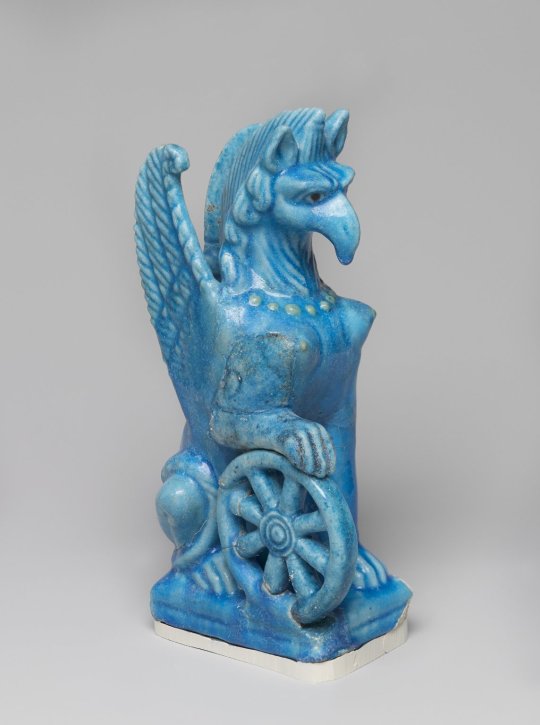
statuette of Nemesis in the form of a female griffin with wings, Roman Egypt (2nd century CE), earthenware and blue faience with yellow faience necklace and black and white glazed eyes
currently in the collection of the Brooklyn Museum (accession no. 53.173)
#isaac.txt#archaeology#egyptology#egypt#egyptian archaeology#roman egypt#roman#art#nemesis#earthenware#faience#brooklyn museum
407 notes
·
View notes
Photo

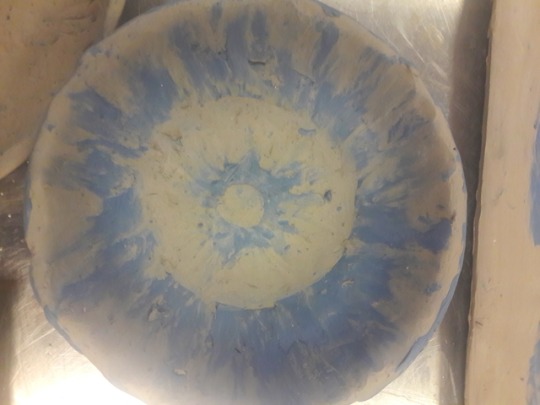
Mélange de deux terres, terre blanche + bleue à étaler en dessinant au doigt
1 note
·
View note
Photo








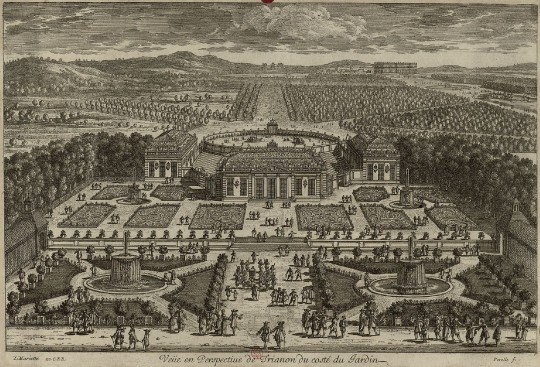
WIP - The King’s Retreat - Part I
Hello Sims community!
My name is Nick and I've been playing The Sims since day one. And since day one, building castles and palaces has always been one of my favourite things to do. Thanks to some CC creators, the possibilities of how we can build in the Sims have changed fundamentally. I would like to thank @thejim07, @felixandresims, @the-regal-sim, @cliffou29 and @themarblemortal in particular for their amazing work. In the past, I lacked the self-confidence to show my buildings to the public. However, the blogs of Cliffou and The Marble Mortal have encouraged me to change this.
I present to you a project I am currently working on. I call it "The King's Retreat" because a great inspiration for the facade and the garden was the "Trianon de porcelaine", a building built in 1670 near the Palace of Versailles, designed by Louis Le Vau. The Trianon de Porcelaine served as a banquet house and retreat for Louis XIV and his mistress Madame de Maintenon. The building was decorated with white and blue faience ceramic tiles “a la chinoise”. It is considered to be the first Chinoiserie building in Europe. In 1687 the building was demolished because the tiles on the facade were cracking and badly weathered. Furthermore the king's affair with Madame de Montespan had ended and his new mistress, Madame de Maintenon, disliked the building. The Trianon de Porcelaine was replaced by a new structure, designed by Jules Hardouin-Mansart, the Grand Trianon we know today.
In my interpretation of the Trianon de Porcelaine, I have taken some liberties with the composition of the facade and the layout of the garden, but still tried to retain the essence of late 17th century Baroque architecture. I dispensed with the porcelain decoration altogether and built it in smaller dimensions (not least because of the limited lot size). I hope you like it anyway. :)
#sims#sims4#sims architecture#sims historical#ts4#ts4 build#the sims 4#chateau#trianon#grand trianon#louisxiv#louis xiv#palace#baroque#sims 4 build#sims4build#thesims#cc#thejim07#felixandre#felixandresims#cliffou29#cliffou#themarblemortal#regalsims#build#simscommunity
153 notes
·
View notes
Photo

An Egyptian white faience ear plug New Kingdom, 18th-19th Dynasties, circa 1550-1185 B.C. Of typical mushroom form, the discus terminal decorated with a marguerite white and blue flower with separately applied red boss in the centre. An ancient ear stretcher
21 notes
·
View notes